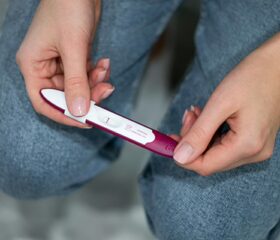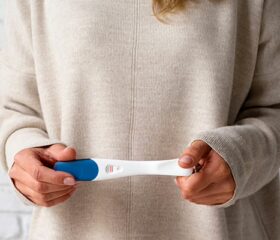Pregnancy Tests: Types, When to Take One, and How to Read the Results
Is your period late? Are you feeling nauseous, and do you need to pee all the time? If so, chances are, you’re pregnant—congratulations! Still, you’ll need to take a pregnancy test to confirm it.

There’s no shortage of pregnancy tests out there, and it can be overwhelming to pick a brand, let alone figure out how to use it. Don’t worry if you’re new at this; pregnancy tests aren’t actually all that complicated.
Read on to learn all about them, including how they work, when to take them, and how to read the results.
How do pregnancy tests work?
At-home pregnancy tests determine if you’re pregnant by detecting a type of hormone called human chorionic gonadotropin (hCG) in your urine.
Your placenta (which develops when you’re pregnant) produces this hormone soon after implantation occurs (when your embryo attaches to your uterine wall). 1 hCG levels rise quickly in early pregnancy, typically doubling every 48 hours. 2
Your body will usually have produced enough hCG about 12–15 days after conception for urine tests to detect, assuming you have a regular 28-day cycle.
Once you’ve endured this two-week wait, you’ll reach the date your next period is due. This is why you’re supposed to take an at-home pregnancy test when you miss your period. Before that, there generally won’t be enough hCG in your urine for the test to show a positive result, even if you’re pregnant.
How accurate are pregnancy test results?
Urine tests give highly accurate results. Most brands promise up to about 97%–99% accuracy, provided you use the product correctly. 3 4
Blood tests are even more accurate than urine tests, and you can use them earlier (i.e., before you miss your period). However, they aren’t available over the counter. You’ll need to visit a doctor if you want one.
What types of pregnancy tests are there?
If you think you’re pregnant, you can either take a urine or a blood pregnancy test. As mentioned, both are very accurate if you follow their instructions and use them at the right time.
Urine tests
A urine test is the most accessible, affordable, and convenient type of pregnancy test. While most women take these tests at home, you can also take one at your doctor’s office.
You can buy urine tests over the counter at most drugstores, pharmacies, grocery stores, and even some dollar stores. You can get a single urine test for under a dollar, although some cost $10+ (for digital tests).
How to take a home pregnancy test
When you take the test at home, double-check the expiration date and carefully follow the instructions. In most cases, you’ll take the test in one of the following three ways:
- Hold the test stick directly in your urine
- Use a cup to collect your urine and dip the test stick into it
- Use a dropper to place urine from the cup directly onto the test
Reading the results: These will usually show within a few minutes. You’ll see a line, a color change, or a symbol (like “+” or “-”). Digital tests may show the words “pregnant” or “not pregnant.”
A line (including a faint line) usually indicates a positive result, although you may want to take a second test to be sure. Bear in mind that on non-digital pregnancy test strips, there will also probably be a “control” line that will show up to prove that the test is working correctly. Make sure you’re looking at the right thing.
Are all home pregnancy tests the same?
Home pregnancy tests all function in the same way and are generally reliable. However, their sensitivity levels can vary. Some expensive tests may detect pregnancy sooner and show results quicker than cheaper ones.
You might be able to detect your pregnancy days before you miss your period and get the result in just a few seconds with a digital test, but make sure you read the instructions carefully to confirm how early you can use your pregnancy test. 5 When in doubt, waiting a few days will always give you a more accurate result.
Blood tests
Blood tests can detect pregnancy as early as 6–8 days after ovulation by measuring the hCG in your blood (which accumulates faster than the hCG in your urine). 6
Again, if you want a blood test, you probably won’t be able to buy it yourself. You’ll need to visit a doctor’s office and wait a few hours to a day for the results. 4
Types of blood tests
There are two types of blood tests: 5
- Qualitative hCG test: This test simply confirms whether you have hCG in your blood and gives a straightforward “yes” or “no” result.
- Quantitative hCG test (beta hCG test): This test measures how much hCG is in your blood. It’s more sensitive and can detect tiny amounts of hCG early in pregnancy.
If you’re undergoing fertility treatments, you might take a beta hCG test to check if your treatments are working. If your doctor thinks there’s something wrong with your pregnancy (e.g., you have a condition that could threaten a miscarriage), they may also ask you to take several beta hCG tests to monitor your hCG levels over time. 2
Do DIY pregnancy tests work?
You may have read online that you can create your own pregnancy tests at home, often with household materials. For instance, you can supposedly test for pregnancy with:
While it may be tempting to go the DIY route, these tests have no scientific backing and don’t actually work. You’re best off sticking with the tried-and-tested methods.
When should you take a pregnancy test?
As mentioned, with most at-home urine tests, you need to wait to take them until the day you miss your period.
The best time to take the test is when you’ve just woken up in the morning. That’s when your urine is most concentrated, meaning your hCG levels are more concentrated. 7 If you decide to test later in the day, avoid drinking a lot of fluids in the hours before testing to avoid diluting your urine.
What happens if you test too early?
If you test before your missed period, your hCG levels may not be high enough to be detected. This could give you a false negative result, wasting your money and misleading you.
As mentioned, some higher-end urine tests advertise that you can use them a few days before a missed period. That said, it’s generally best to wait until at least a day after your period was due for the most reliable outcome. 3
When to take a blood test
You usually won’t take a blood test unless your doctor recommends it. If so, they’ll schedule the tests for you, so you don’t have to worry about the timing. You can also ask for a blood test to confirm your pregnancy if you get a positive result on your home urine test.
How to know when to test if you have an irregular cycle
It’s possible to get pregnant with irregular periods, but they can make it tough to know when to test (since a missed period isn’t a reliable sign of pregnancy when you have irregular periods). If you’re testing for pregnancy with an irregular cycle, take the test 36 days after your last period started, or four weeks after having sex.
How do you interpret home pregnancy test results?
Here’s a more detailed breakdown of the different results you might see when you test for pregnancy:
Positive result
Because different brands of tests show their results in different ways, you’ll need to refer to the instructions to be sure how to read yours. However, on many tests, a positive result will show up as a line.
Seeing that line usually means you’re pregnant, no matter how faint it is. A faint line on a pregnancy test is still a positive result.
That said, if you wait too long to read the test, a faint line could just be an “evaporation line,” which shows up after your urine dries. To avoid this, read the test within the recommended time frame.
Potential causes of false positives
False positive pregnancy tests due to deficient tests happen, but they’re rare. If you don’t trust a positive result, take another test again; getting two false positives due to a manufacturing defect is very unlikely.
Most medications, including birth control and antibiotics, don’t affect home pregnancy test results. Neither do alcohol and most drugs, although you should stay away from those if you’re trying to conceive; they might cause pregnancy complications like premature birth, birth defects, and infant death. 8
With that said, medicine that includes hCG can lead to a false positive. The most notable example is infertility medicine. That’s why doctors usually ask women undergoing fertility treatments to take beta hCG tests (to measure the exact amount of hCG in the blood).
The list of medications that may affect your test also includes benzodiazepines (a class that includes alprazolam, aka Xanax). Talk to your doctor to see if you’re taking anything that could render a pregnancy test unreliable. 9 10
Another instance where you might get a false positive is if you recently had a miscarriage. Note that sometimes, you might not know you had a miscarriage if it occurred very early, before you knew you were pregnant at all. 11
Negative result
If you got a negative result and you’re sure you didn’t take the test too early, you’re probably not pregnant. However, if you still suspect you might be, retest in a few days or a week. Be sure to test first thing in the morning, before drinking anything.
It’s a good idea to call your doctor if you think you’re pregnant despite getting two negative results from tests taken days apart. They’ll assess your situation and may schedule a blood test for you. 4
If you’re testing because you missed your period, keep in mind that pregnancy isn’t the only factor that can affect it. You might miss a period or get a very late one due to stress, hormonal imbalances, changes in your weight, or other underlying medical issues. 12 In any case, your doctor can help you figure out the problem.
Potential causes of false negatives
False negative results are more common than false positives. They can be caused by:
- Testing too early when your body hasn’t produced enough hCG
- Drinking too many fluids and diluting your urine
- Using an expired test that doesn’t work properly
- Following the test instructions incorrectly
What should you do after getting a positive pregnancy test?
After you get a positive result, follow up with your doctor to confirm the pregnancy and discuss your options.
Your doctor will probably ask you to start taking prenatal vitamins if you haven’t already been doing so. Look for prenatal vitamins with 400–800 mcg of folic acid. This is a type of Vitamin B that prevents major birth defects (especially in your baby’s developing brain and spine). 8 13
It’s also important to maintain a healthy lifestyle. Eat a nutritious pregnancy diet, stay hydrated, exercise regularly, and avoid alcohol entirely when you’re pregnant, along with other harmful drugs or medications (except for pregnancy-appropriate ones prescribed by your doctor).

Final thoughts
By and large, home pregnancy tests are easy to use and effective. You’re unlikely to run into any issues as long as you follow the instructions and don’t test too early.
When in doubt, give your doctor a call. They’ll walk you through any confusion you have.
Article Sources
- US Food and Drug Administration. "Home Use Tests – Pregnancy" Retrieved May 14, 2025.
- Florida Agency for Health Care Administration. "Health Encyclopedia: Pregnancy test" Retrieved May 14, 2025.
- Pregnancy tests. "Office on Women's Health" Retrieved May 14, 2025.
- MedlinePlus. "Pregnancy Test" Retrieved May 14, 2025.
- Hope Women's Center. "Are Digital Pregnancy Tests More Reliable Than Traditional Ones?" Retrieved May 14, 2025.
- Office on Women's Health. "Knowing if you are pregnant" Retrieved May 14, 2025.
- MedlinePlus. "Medical Encyclopedia: Pregnancy test" Retrieved May 14, 2025.
- Centers for Disease Control. "Planning for Pregnancy" Retrieved May 14, 2025.
- Blue Ridge Women's Center. "What Causes a False Positive or Negative Pregnancy Test?" Retrieved May 14, 2025.
- Ekol International Hospitals. "Can Medications Affect Pregnancy Test Results?" Retrieved May 14, 2025.
- Eunice Kennedy Shriver National Institute of Child Health and Human Development. "Pregnancy Loss (Before 20 Weeks of Pregnancy)" Retrieved May 14, 2025.
- American Family Physician. "Amenorrhea: A Systematic Approach to Diagnosis and Management" Retrieved May 14, 2025.
- Office of Disease Prevention and Health Promotion. "Eat Healthy During Pregnancy: Quick Tips" Retrieved May 14, 2025.







